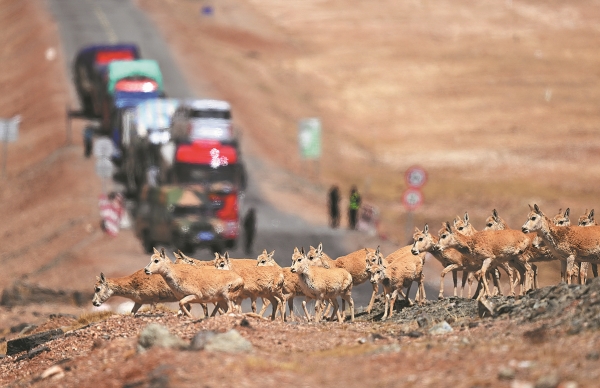Tibetan antelopes arrive in Hoh Xil to calve
Updated: 2023-07-18 (Xinhua)  Print
Print 



A herd of female Tibetan antelopes crosses a highway in the Hoh Xil National Nature Reserve in Qinghai province on May 29. ZHANG HONGXIANG/XINHUA
XINING — Female Tibetan antelopes are giving birth on a large scale in the Hoh Xil National Nature Reserve, according to local authorities.
Around May each year, tens of thousands of pregnant Tibetan antelopes start their migration to Hoh Xil in Qinghai province to give birth, leaving with their offspring in late July.
The Hoh Xil management office, administered by the management bureau of the Sanjiangyuan National Park, has been monitoring the animals' movements. On April 26, the first group of 26 antelopes migrated from the 3,001-kilometer mark on the Qinghai-Tibet Highway to Drolkar Lake in the hinterlands of Hoh Xil, according to the office. The Drolkar Lake area, which is more than 4,800 meters above sea level, is the main birthing ground for the species.
"Rain and snow affected the speed of migration of the antelopes," said Tsesogyal, a staff member at the Drolkar Lake protection station, adding that more than 30,000 female Tibetan antelopes are currently giving birth in the lake area, and the herds have spread across the meadows and hillsides around the lake.
Wu Xiaomin, an expert in Tibetan antelope protection, said the reason the animals gather at the lake to give birth remains a mystery.
Drolkar used to be one of the most popular places for poaching Tibetan antelope and so in order to ensure their smooth migration, the Hoh Xil management office sets up a special seasonal protection station to monitor the arrival of the females and the birth of their calves.
"During breeding season, the staff strengthen patrols in the area around Drolkar Lake, focusing on looking for traces of human activity such as ruts and footprints nearby, and observing the birth of Tibetan antelopes by telescope. Human interference with calving should be avoided," Tsesogyal said.
According to Pugdrug, director of the Hoh Xil management office, thanks to the continuous strengthening of environmental protection, there have been no cases of antelope poaching in Hoh Xil since 2009.
"The staff also rescue calves that have become separated from their herds, and the population of Tibetan antelopes in Hoh Xil has recovered to more than 70,000," Pugdrug said.
The status of Tibetan antelopes in China has been downgraded from "endangered" to "near threatened". During the 1980s and 1990s, due to poaching sprees, the population of Tibetan antelopes in Hoh Xil dropped to less than 20,000.
Tibetan antelopes now enjoy first-class State protection in China, and are mostly found in the Tibet autonomous region, Qinghai province and the Xinjiang Uygur autonomous region. The species plays a key role in maintaining the ecological balance of the Qinghai-Tibet Plateau.
Xinhua








